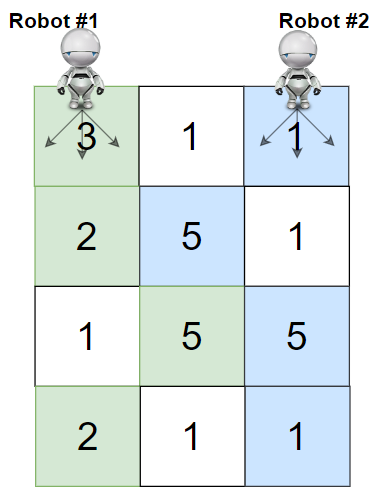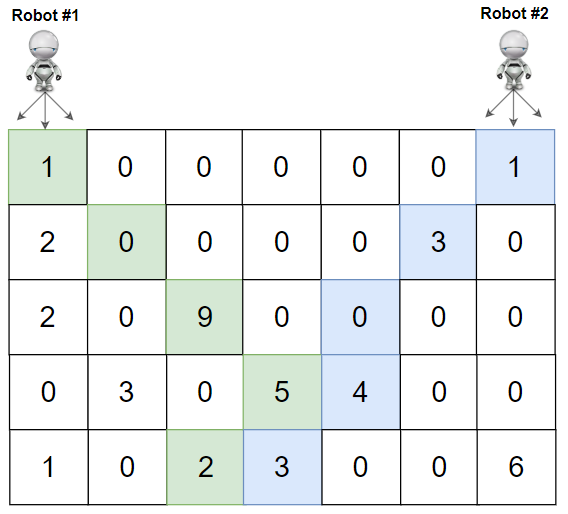Problem
Given a rows x cols matrix grid representing a field of cherries. Each cell in grid represents the number of cherries that you can collect.
You have two robots that can collect cherries for you, Robot #1 is located at the top-left corner (0,0) , and Robot #2 is located at the top-right corner (0, cols-1) of the grid.
Return the maximum number of cherries collection using both robots by following the rules below:
- From a cell (i,j), robots can move to cell (i+1, j-1) , (i+1, j) or (i+1, j+1).
- When any robot is passing through a cell, It picks it up all cherries, and the cell becomes an empty cell (0).
- When both robots stay on the same cell, only one of them takes the cherries.
- Both robots cannot move outside of the grid at any moment.
- Both robots should reach the bottom row in the
grid.
Example 1:

1 | Input: grid = [[3,1,1],[2,5,1],[1,5,5],[2,1,1]] |
Example 2:

1 | Input: grid = [[1,0,0,0,0,0,1],[2,0,0,0,0,3,0],[2,0,9,0,0,0,0],[0,3,0,5,4,0,0],[1,0,2,3,0,0,6]] |
Example 3:
1 | Input: grid = [[1,0,0,3],[0,0,0,3],[0,0,3,3],[9,0,3,3]] |
Example 4:
1 | Input: grid = [[1,1],[1,1]] |
Constraints:
rows == grid.lengthcols == grid[i].length2 <= rows, cols <= 700 <= grid[i][j] <= 100
Analysis
这是一道二维矩阵的题目,两个robot在上面走,走过的格子能够获得上面的cherries,问两个robots最多能获得多少个cherries。其中两个robot的移动方向只能是左下、正下、右下。首先要确定解题的思路,因为这里的总数每条路径是不同的,而且如果两个机器人走到同一个格子的话,只算一个机器人,所以这里一定要把整个流程走完,而且是两个机器人一起走。
确定好要遍历之后,先来看看每次移动的方向。每个机器人都有三个选择,所以两个机器人一共就有9种组合。对每一个组合都计算出结果,然后在所有的结果中挑选最大的,就是这一步能够获得的最多的cherries,所以这里就用到了递归。入参是位置,出参是获得的最大cherries的数量,再加上当前位置的cherries,就得到当前位置能够获得的最大的cherries了。
Solution
这道题目的思路并不复杂,就是递归遍历,难点在于如果把这个递归写的漂亮。首先入参是位置,所以位置信息需要传入,两个机器人各自的坐标一共四个值,但是因为两个机器人都是同时往下走,所以他的纵坐标是一样的,这里可以减少一个维度,只传3个。
同时,在使用递归的时候我们经常会遇到重复计算的问题,一般的解决方法就是用一个map或者数组去存放计算过的结果。这里是三个维度,所以用一个三维数组存计算过的结果,这样能够提高运算效率。
Code
1 | class Solution { |
Summary
这道题目本质上还是一个遍历的问题,一般这种地图类的遍历会使用BFS/DFS,或者就是递归了。递归函数的出参一般都是答案,入参是位置信息,同时还要顾及到计算效率的问题。这道题目综合考察了coding的几个方面,非常值得总结。这道题目的分享到这里,谢谢您的支持!

